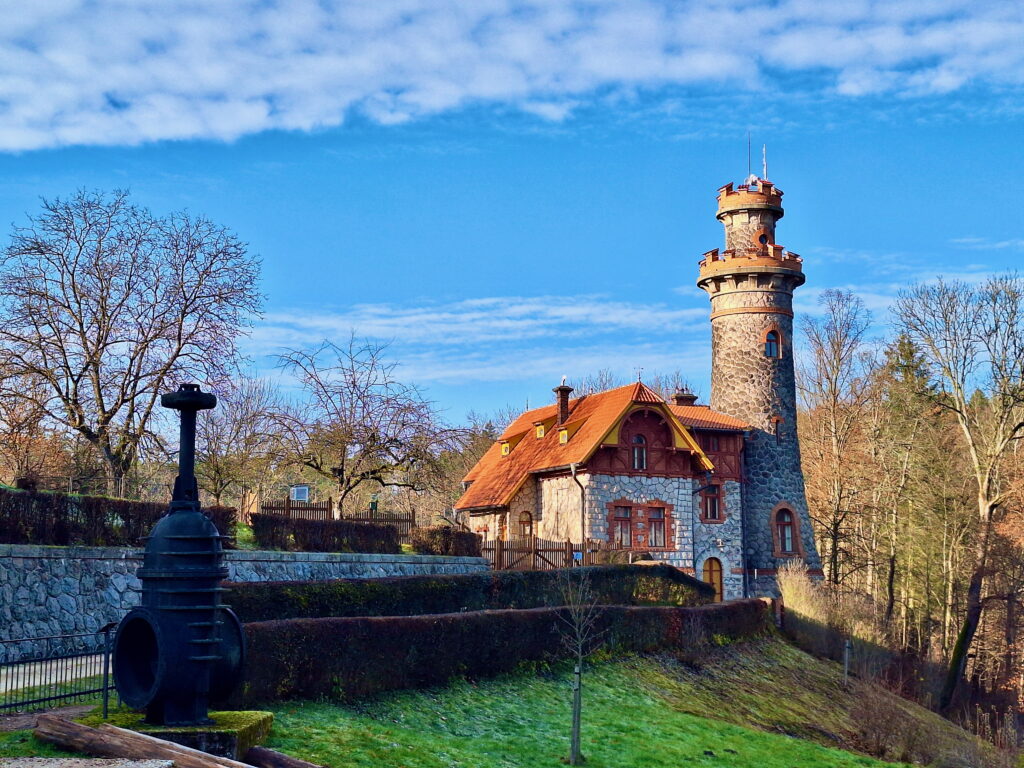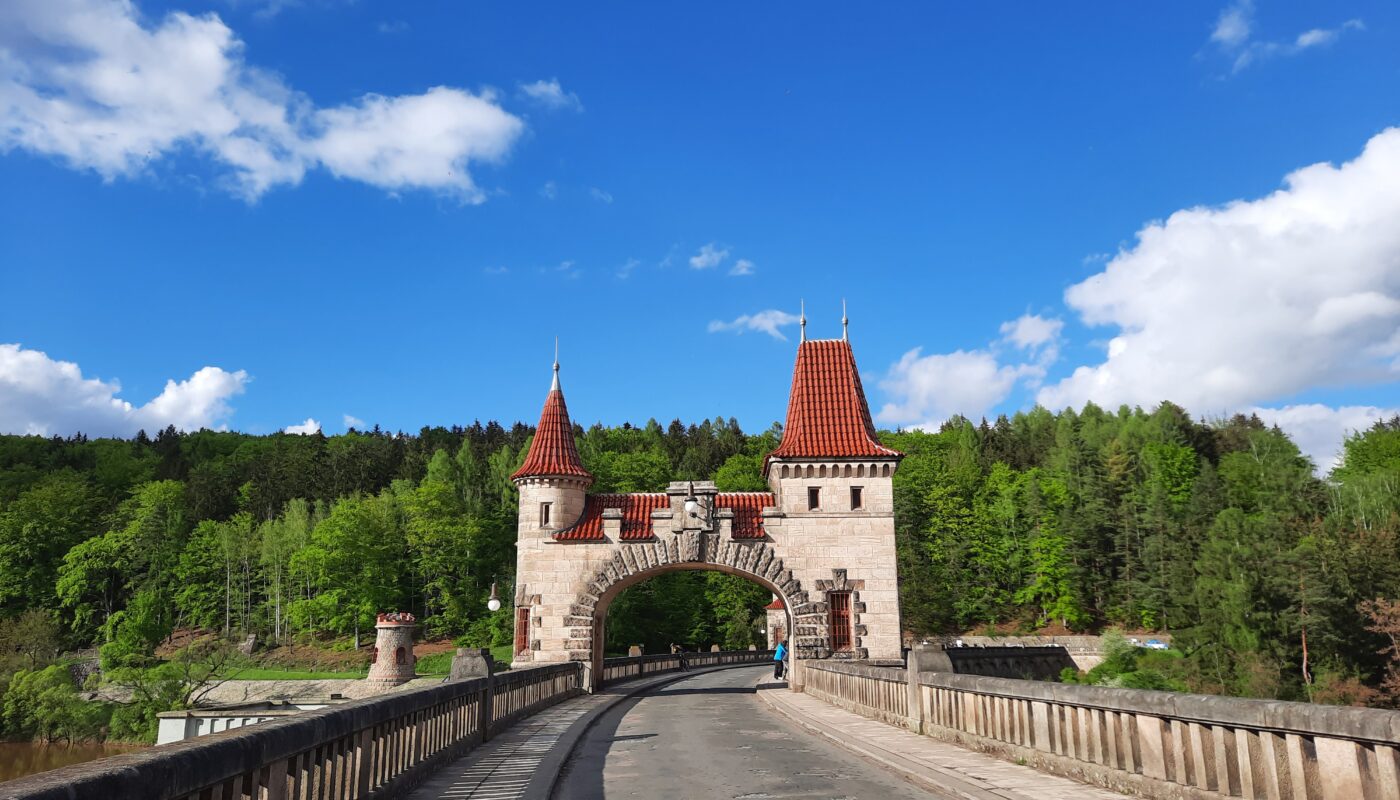Reading Time: 5 Minutes 39 Seconds
Historical info
The impressive Les Království dam is located on the Elbe river, in the Hradec Králové region.
It is a unique and remarkable dam, because it features a romantic pseudo-Gothic design that harmonizes with the beautiful surrounding nature.
The dam’s name derives from the extensive forest on its left bank (translated into English as “the Forest Kingdom”).
It is also commonly referred to as the dam of Bílá Třemešná, named after the nearby village, or Těšnovská (i.e. of Těšnov), referencing the remains of the submerged village.
The erection of the dam was initiated in response to the catastrophic flood of July 1897, which hit the Elbe valley up to Pardubice. However, it was only with a specific act of 1903 that the construction of dams began to be regulated.
The project was developed by the technical office for river management in Prague, under the direction of engineer Josef Plicka.
Architect Jaroslav Valečka was responsible for the design of the dam’s stonework, while the construction was handled by the Prague firm of engineer Jaroslav Václav Velflík.
The production of the iron structures was assigned to another Prague based company, Fanta & Jireš.
The planning for the dam started in 1903 and the construction began in 1910.
Due to delays caused by World War I, the dam was not put into operation until 1920, but the first time the unfinished dam served its purpose was in 1917, when it was filled to the level of the safety spillways.
At the time it was completed, Les Království was the longest dam and the largest reservoir in the Czechoslovak Republic in terms of amount of water.
The dam has been protected as a technical monument since 1964 and was in 2010 it designated a national cultural monument.
Characteristics of the Les Království dam
The dam is constructed from blocks of sandstone, renowned for their high hardness, which were quarried nearby in the Těšnov valley.
The chosen site for the dam was suitable under the geologically point of view, as the floor of the Elbe valley consists of solid and almost impermeable igneous rocks of basaltic type.
At the bottom of the valley, the igneous rock in the middle of the Elbe riverbed is only 7m deep.
The dam comprises nearly 95,000 m3 of masonry, extending over 200m in length and approximately 37m in width.
Its thickness decreases as it rises, reaching 7.2m at the crown, where the overflow point is located, and narrowing to 4.2m at road level.
The height of the dam wall from the ground is 32.7m, with a depth of about 28m.

The flooded area of the reservoir is almost 850,000 m2, with a storage volume of 2.47 million m3 of water, although it was originally designed to accommodate almost 9.2 million m3 (during flood events).
It is an arch-gravity dam, which means it withstands the horizontal pressure of water through its own weight and the connection between the dam and the foundation rock.
On both sides, the dam features arched doors in a romantic pseudo-Gothic style, decorated with turrets covered in red tiles.
The small hydroelectric power station
The construction of the hydroelectric power plant started some years later, mainly because it was not explicitly included in the original project.
The idea of using the power of the water contained in the dam to generate electricity gradually began to take shape.
The East Bohemian electrification plan included an hydroelectric power station on the dam only in the autumn of 1916. Despite the ongoing war, representatives of the provinces and cities of East Bohemia gathered in Prague on December 1916, to find a solution for electrifying the region using water energy.
The project was again entrusted to the team led by engineer Josef Plicka, and the architectural design was assigned once more to architect Jaroslav Valečka.
The hydroelectric power plant saw the light only after the fall of the Habsburg monarchy and the establishment of the Czechoslovak Republic. The property was handed over in May 1922 and it began operating in March 1923.
The small power plant building is located on the right bank below the dam and resembles a small stone castle with a dominant crenellated tower.
Initially it was equipped with two horizontal Francis turbines with double boiler, supplied by the Českomoravská Kolben company in Prague Vysočany.
These turbines were of the same type of the ones used in the Štvanice hydroelectric power station in Prague.
In 2005 the turbines were replaced by a more modern type due to frequent failures, and the current output of the plant is 2 x 1105 MW.
Les Království today
At present, experts consider the dam to be statically safe.
However, there is a 6m layer of mud that lays at its base, generated from debris and sediments carried downstream by the Elbe River from the Krkonoše Mountains (the Giant Mountains).
While this layer reduces the water storage capacity, it does not compromise the dam’s functionality.

You can visit the dam free of charge at any time of the year.
In one of the former buildings of the dam, there is an exhibition that traces the history of the area and of the dam up to the present day.
From this building, you can climb a spiral staircase to the lookout tower, which offers a stunning view of the surrounding landscape.
The exhibition and the building are open only during July and August, from Thursday to Sunday, and advanced online reservation is required.
The official website provides you with myriad of information and insights, both historical and technical, as well as a live webcam and the booking system.
How to get there
The dam is easily reachable by car and you can even drive on it.
There are two parking spots very close to the dam, one in front of the other, and they are probably paid. Check this out, as I am not sure about the recent updates. Once I was there by bike and the second time we parked a bit away to do a loop hike.
You can also chose to travel by train, and in that case you reach Jaroměř first and change there for another tiny train to Bílá Třemešná. From the train station it is a 4km walk till the dam.
Always consult pubtran.cz or České dráhy before travelling.
Activities in the surrounding
By the dam you find a kiosk with few outdoor tables, where you can get typical Czech ready-to-go food.
Or can opt for the grill, pizzeria and pancake place at the Štěrbova vila.
- Hiking
You can have a short or long walk in the surrounding forest, depending on your liking and timing.
The walk along the dam and then into the forest is really worthy.
We did a tiny loop of 8km and took the chance to see the two wooden pedestrian bridges (the lower and the upper) over the Elbe, which are listed as cultural monuments. - Cycling
I reached Jaroměř by train and started my ride from there. I first went to Kuks, then to Les Království dam.
This is a short ride, good for a lot of sightseeing or for winter days.
If you are a religious person or are into religious art, you can add the section of the “Via Crucis of the 21st century” and reach the Betlém.
The Via Crucis is a collection of 15 sandstone sculptures installed in 2008, that depict the so-called “story of suffering and hope of the man”.
The Betlém (the Nativity) is a distinctive Baroque group of sandstone sculptures and reliefs created by the famous Austrian sculptor Matyáš Bernard Braun between 1711 and 1734.

